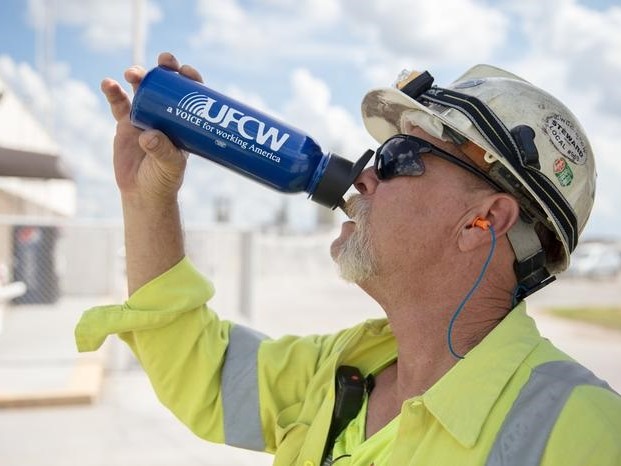The UFCW’s Occupational Safety and Health (OSH) Office has guidelines to help locals protect our members from the risk of heat illness this summer.

Why does heat safety matter? Millions of workers in the United States are exposed to heat on the job. Both indoor and outdoor industries are at risk, including but not limited to agriculture, construction, food processing, iron and steel mills, and manufacturing.
In hot conditions, the human body works constantly to maintain a normal body temperature. But when the heat becomes too much for your system to handle, heat-related illnesses—such as heat exhaustion, heat stroke, and other conditions—can be life-threatening.
What is heat acclimatization? Heat acclimatization is like easing into a hot bath. Initially, the sudden temperature change feels intense, but as you settle in, the body adapts, and the heat becomes tolerable. Proper heat acclimatization is done by gradually increasing heat exposure over a seven to 14-day period. This practice allows the body to stabilize blood circulation, release sweat more efficiently, and reduce cardiovascular strain while performing tasks.
What is a heat-related illness? A heat-related illness occurs when the body cannot efficiently cool itself. This occurs when workers are exposed to prolonged amounts of heat without adequate hydration.
Workers should be trained on how to identify and address the following illnesses:
Heat stroke occurs when the body can no longer regulate its temperature due to failed cooling mechanisms. This condition is extremely dangerous and can be fatal if immediate medical help is not administered. Key symptoms include body temperature greater than 104 degrees Fahrenheit, hot, dry skin, inability to sweat, altered mental state or confusion, slurred speech, and loss of consciousness. If someone begins showing signs of heat stroke, a quick response is critical, and the following steps should be taken:
• Call 911 immediately.
• Move the worker to cool area and remove any unnecessary clothing.
• Cool the worker as quickly as possible (cold water/ ice bath, wet the skin, soak clothing with cool water).
• Stay with the worker until emergency medical personnel arrive.
Heat exhaustion is a condition that occurs when the body begins to overheat. It may be gradual or sudden and can progress to heat stroke if not treated. Key symptoms include headache, nausea, dizziness, thirst, excessive sweating, and a body temperature between 101 and 104 degrees Fahrenheit. If someone begins showing signs of a heat stroke, the following steps should be taken:
• Transport the worker to a clinic or emergency room for treatment. If medical care is not available, call 911 immediately and stay with the worker until emergency medical personnel arrive.
• Move the worker to a cool area and remove any unnecessary clothing.
• Give the worker cool liquids to drink and encourage them to take frequent sips.
• Cool the worker down by applying a cold compress to the head, neck, or face.
Heat cramps are brief, painful muscle spasms that occur when experiencing electrolyte loss and dehydration. Key symptoms include muscle spasms, or involuntary jerking movements accompanied with pain. If someone begins experiencing heat cramps, the following steps should be taken:
• The worker should be given water and a snack every 15 to 20 minutes to replace lost electrolytes and carbohydrates. A carbohydrate electrolyte replacement drink (such as a sports drink) can also be given.
• If symptoms do not subside or worsen, get help from professional medical personnel. Workers who have heart problems or are on special diets should also seek help from professional medical personnel.
Heat rash is the most common heat illness and presents in the form of small red bumps or blisters. These blisters may appear in clusters on the chest, scalp, underneath breasts, and in the groin area. Heat rashes can be addressed using the following steps:
• Transfer the worker to a cool, less moist environment.
• Apply a rash powder to ease discomfort and keep the area dry.
• Ointments and creams should be avoided, as they may make the rash worse.
What can be done to prevent heat illness? Employers should ensure that all employees have access to:
• Proper acclimatization methods.
• Adequate amounts of cool drinking water.
• Cool/shady rest areas for relief.
• Accessible bathrooms with adequate bathroom breaks.
• Systems for cooling the work environment and general ventilation systems.
• A written protocol for responding to medical emergencies.
• Education and training on heat-related illness and how to recognize a medical emergency.
Here are what some states are doing about excessive heat:
Materials about hydration are available here and OSHA materials about preventing heat stress at work are available in English and Spanish. For more information about heat and heat-related illness, please contact Roy McAllister, the director of the OSH Office, at rmcallister@ufcw.org.
